7 Best PIER FISHING RIGS (Setup & Fishing Guide w Pictures)
PUBLISHED 6 SEPTEMBER 2023
by Robert Ceran
Are you planning to go pier fishing, but aren’t sure which fishing rig is best for your purposes?
While fishing from a pier is generally simpler than boat fishing, it’s essential to use the right rigs to catch fish successfully from piers.
In this article I’ll walk you through the most effective pier fishing rigs, and will also cover how to fish them, and how to choose the ideal setup for your purposes.
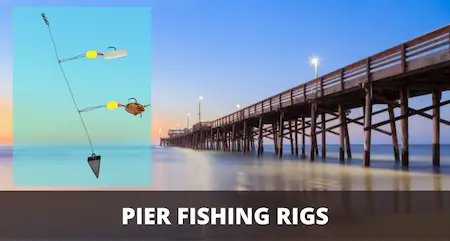
What are the best pier fishing rigs?
The 7 best rigs for fishing from piers are:
- Carolina rig
- Fish finder rig
- Slip bobber rig
- Trolley rig
- High low rig
- Paternoster rig
- Pompano rig
- Sabiki rig
We’ll go over the strengths and weaknesses of each of these rigs for pier fishing in full detail below, so you can decide which one is best for you.
Carolina rig
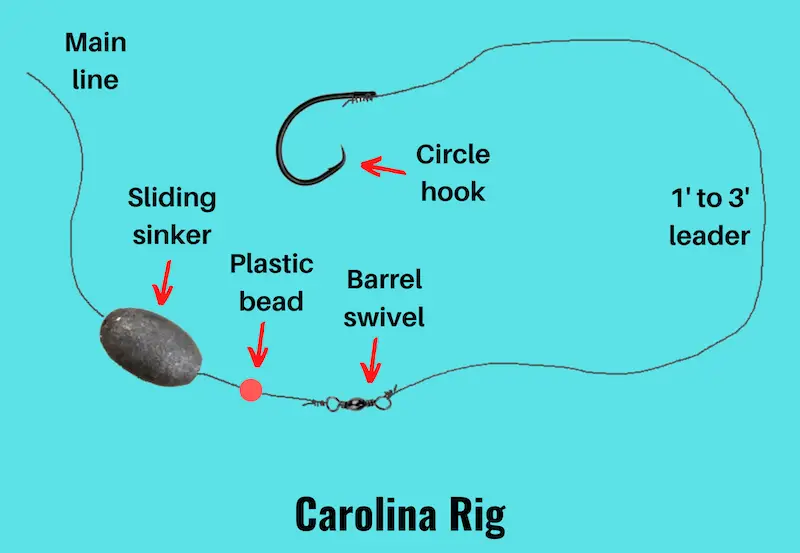
The Carolina rig is one of the most popular bottom fishing rigs for saltwater as well as freshwater, and comes in handy as a great all around rig for fishing from piers.
This setup consists of a sliding egg sinker that rides on the main line, as well as a bead and a swivel that connects the main line to a 2 to 3 foot leader with a circle hook tied at the end.
This bottom rig works equally well for fishing live bait or freshly cut dead bait from a pier, and a wide variety of natural baits, such as squid strips, crabs, sand fleas, or shrimp.
An advantage of Carolina rigging is that the sliding sinker allows a fish to take the bait without feeling the resistance of the sinker.
A great strategy is to cast it out from the pier, and then use a bait clicker to alert you to bites. If you don’t have a fishing reel with a bait clicker, you can also watch the rod tip in order to detect bites.
Fish finder rig
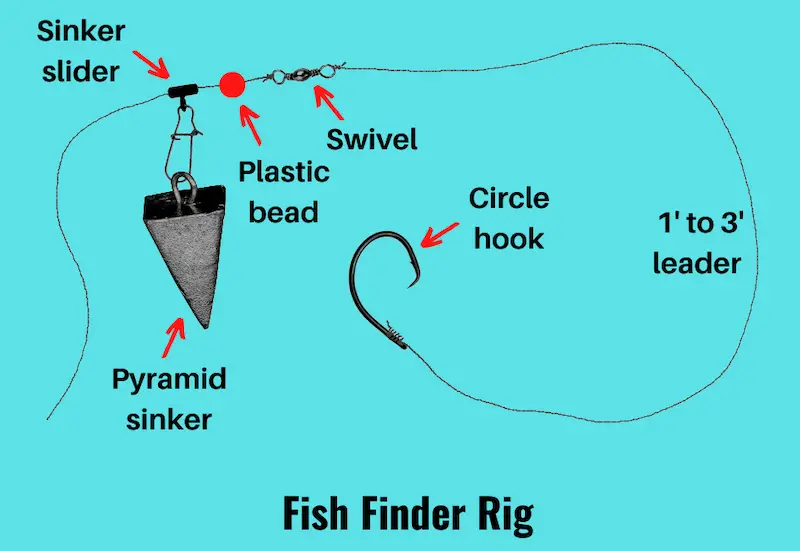
While the fish finder rig is most often used for beach fishing, it’s also very effective for catching fish from a pier.
This saltwater rig consists of a pyramid sinker that rides on the main line with a sinker slide, as well as a swivel that attaches the main line to a leader with a circle hook tied to the end of it.
The basic structure of the fish finder rig is similar to the Carolina rig, but the advantage of this setup for saltwater fishing is that it is made with a pyramid weight, which digs into the bottom, and is able to hold your rig in place even when there are strong currents or tides to contend with at a pier.
I recommend using the Carolina rig when there isn’t much current at your pier, and switching to the fish finder rig if the currents are too strong for an egg sinker to hold the bottom.
Slip bobber rig
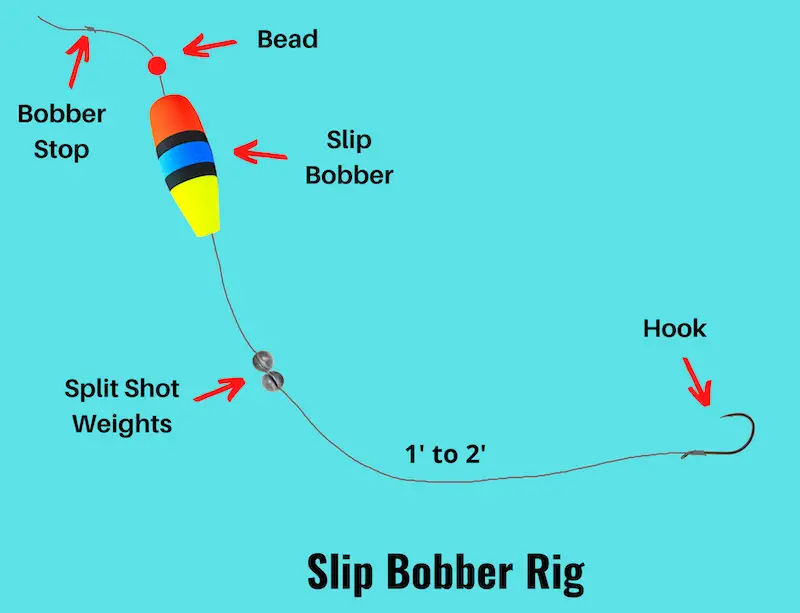
The slip bobber rig can be extremely useful for pier fishing, as it allows you to modulate the depth at which your bait is presented in the water column, enabling you to target suspended fish, or fish feeding close to the surface of the water, such as spanish mackerel, snook, speckled trout or red drum.
This rig consists of a bobber stop and a slip bobber riding on the main line, as well as a barrel swivel that attaches to a monofilament or fluorocarbon leader with a bait hook, J-hook or circle hook at the end.
The main line can be either mono or braid, but I like to use braid because it floats on the water. You can fish this rig in saltwater with a wide variety of baits, including live bait and cut bait. If you know at what depth the fish are suspended, set your bobber stopper accordingly.
If you don’t know the right depth to target around the pier, systematically test different depth settings until you start getting bites.
The nice thing about fishing a slip bobber rig is that you can even use it for deep water, as the bobber stop can easily slide through the line guides of your fishing rod, and you can even spool it onto your spinning reel.
Trolley rig for pier fishing
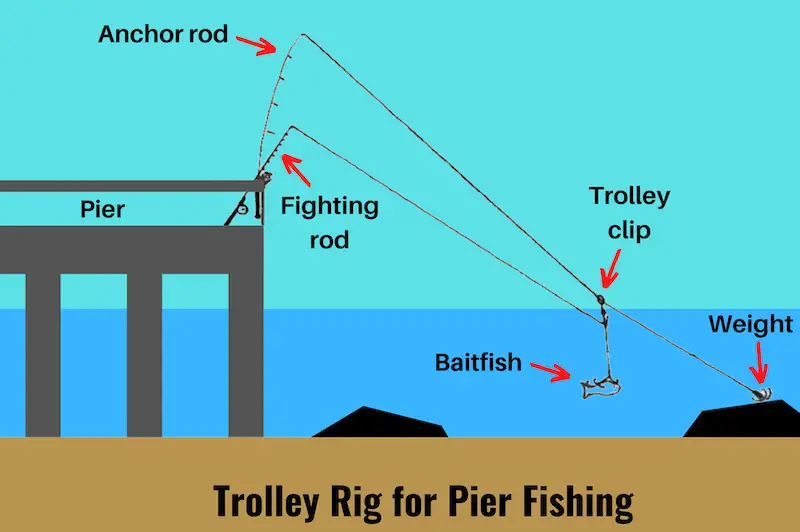
The trolley rig was specifically designed for pier fishing, and requires two rods to set up.
The first rod is used to set an anchor line for keeping the rig in a specific location (also called the anchor rod), while the other is used to fish a baited hook and catch fish (also called the fighting rod).
In order to set up the trolley rig, start by tying a heavy weight to the end of the main line of the anchor rod, and casting it out away from the pier. In some locations it’s best to do this at the end of the pier, as that allows you to reach deeper water.
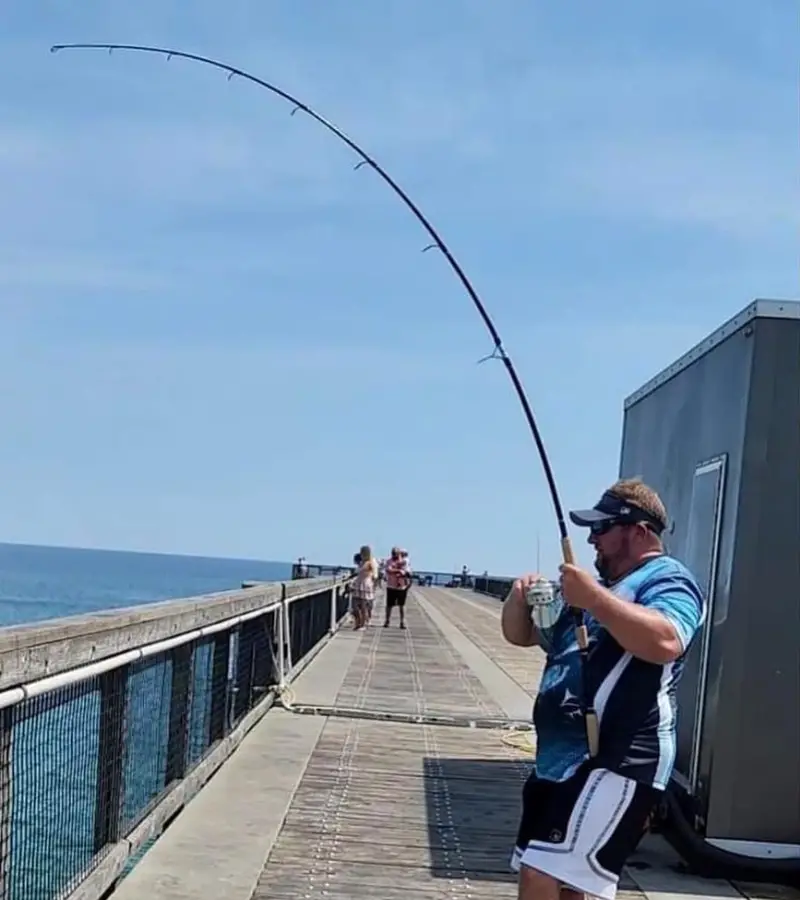
Image source: instagram/@shallowaterfishingco
I like to use a surf casting rod as the anchor rod, and use it to cast a heavy 8 ounce spider weight or storm sinker from the pier, as this type of weight digs into the bottom and stays in place even in very strong currents.
The extra length of a surf surfcasting rod also helps to lift the fishing line high up above the water, which creates a steep angle as it enters the water, which is exactly what you should be aiming for.
Next comes the terminal tackle: start by tying a large circle hook to a heavy mono leader, and then attach this to the main line of your fighting rod via a barrel swivel.
Attach the two wires of the trolley rig clip to one of the eyes of the barrel swivel, and then clip the trolley to the anchor line (usually with a clothespin).
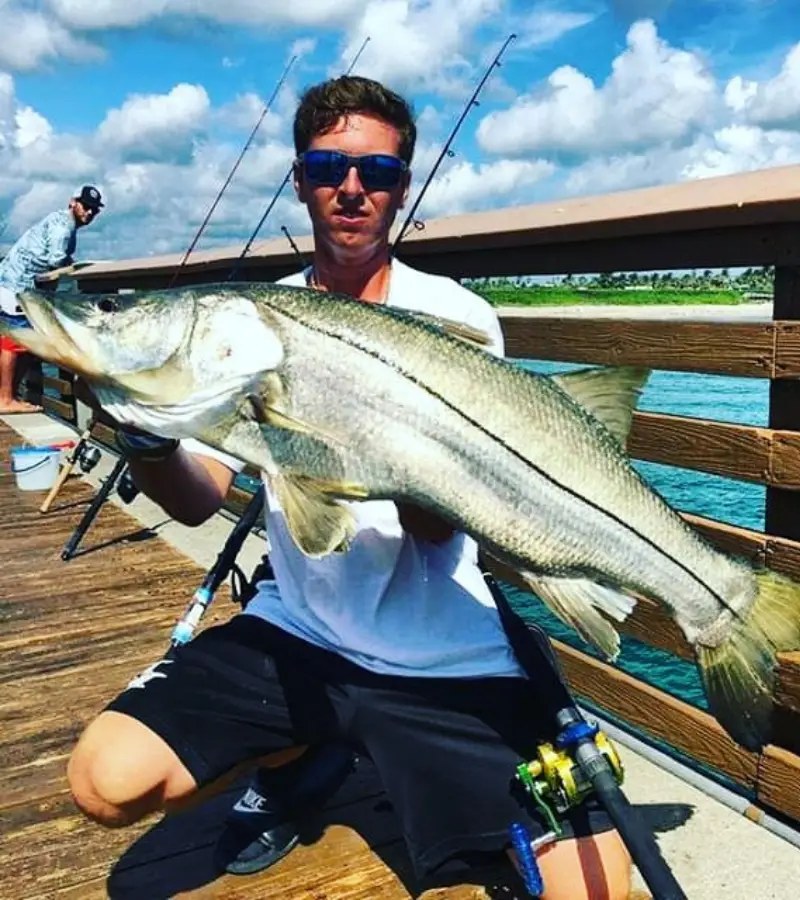
Image source: instagram/@trtackle
After the clip is attached to the anchor line, bait the hook with a live or dead bait fish (such as pinfish, mullet or herring) and open the bail of the fighting rod, which allows the trolley rig to slide along the anchor line until it reaches the water surface.
A nice thing about this saltwater setup is that when a fish grabs the bait, the fighting line is released from the trolley clip, and the angler on the pier can set the hook.
The strength of the trolley rig is that it can keep a live bait in position even in strong currents, and all you have to do is wait for a bite. On the downside, however, it is relatively complex to set up, and isn’t allowed on all piers (especially in Florida).
Pompano rig
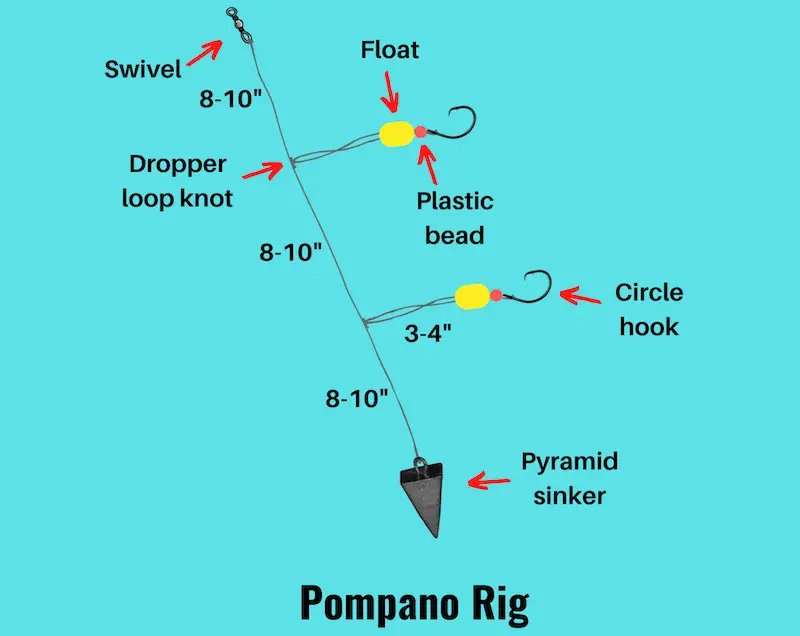
The Pompano rig setup for bottom fishing comes with the advantage of having small floats attached next to the hooks, which keeps them up off the bottom when fishing from piers.
This saltwater fishing rig consists of a weight attached to the end of the line, in addition to either 2 or 3 hooks attached to short snoods above the sinker.
A small bright float is threaded onto each snood, and sits right next to the hook. The colored float not only lifts your bait off the bottom, but also helps to attract fish.
You can use this saltwater setup not only for pompano, but also for other fish that feed close to the bottom around piers, including sheepshead, whiting, snapper, croaker, fluke and flounder.
High low rig
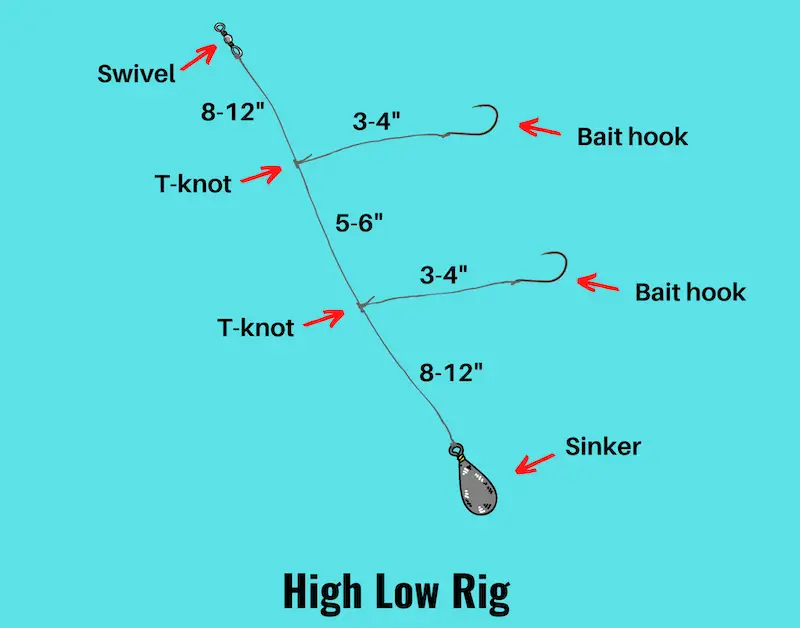
The high low rig is a double hook bottom rig that is very effective for catching fish from a pier. It is distinguished from similar setups by virtue of using T-knots to tie the snoods that the hooks are attached to.
The setup consists of a sinker tied to the end of the line, as well as several hooks tied to snoods above the weight with T knots.
T-knots have the advantage of sticking out at 90 degrees from the leader, which helps to avoid line tangles between the hooks and the rest of the fishing rig.
The tangle-free nature of the high low rig makes it easy to cast with, which means you can cover a lot of ground by casting out from a pier, instead of being restricted to fishing vertically for fish that forage between the piles of the pier.
Paternoster rig
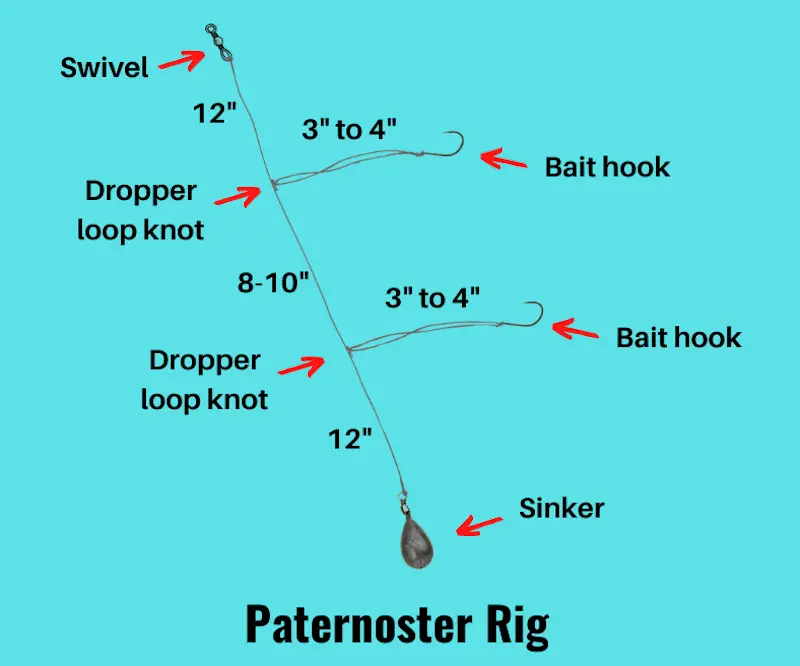
The paternoster rig is a multi-hook saltwater rig that comes with the advantage of being easy to tie and easy to fish, making it an ideal pier fishing setup for beginners.
It consists of a heavy bank sinker tied to the end of the line, as well as 2 to 3 hooks attached to the line above the sinker with dropper loop knots.
Dropper loop knots are easier to tie than T-knots, which is why the paternoster rig is better suited for beginners than the high low rig.
The best way to fish this bottom rig is to lower it vertically into the water from the pier, which works well if the water is deep enough and there are fish feeding around the piles.
You can also cast this saltwater rig from the pier, but if you cast it further than about 50 feet, you’re likely to get line tangles.
Sabiki rig
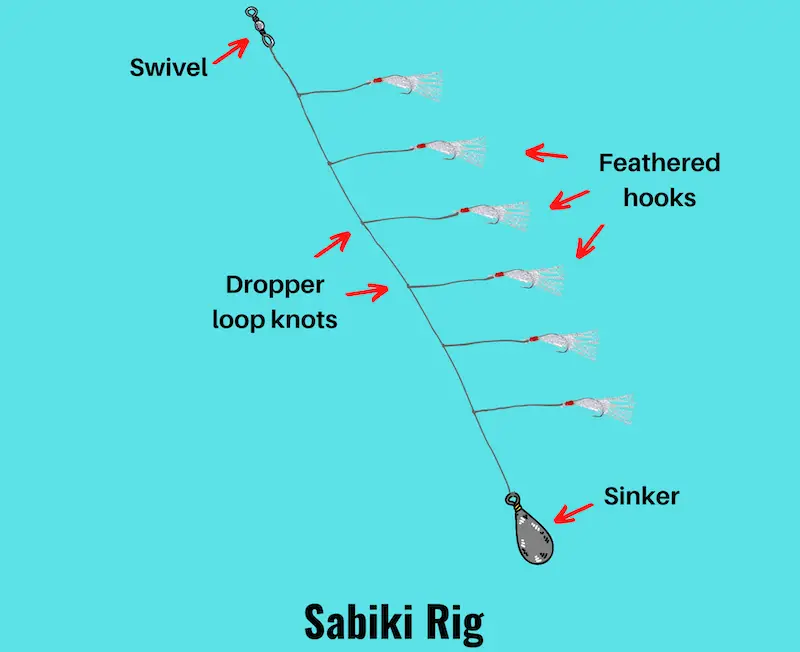
The Sabiki rig is another multi-hook pier fishing rig that is exclusively used for vertical fishing. It consists of a long leader of up to 6 feet, which is tied to a heavy bank sinker at the end.
Above the leader, 5 to 15 feathered hooks are tied to the leader via short dropper loops that have been cut, about 8 inches apart from each other.
The feathered hooks of the Sabiki rig are great for catching small pelagic fish, such as mackerel, pilchard, and sometimes also bonito.
The Sabiki is also a great setup for deep sea fishing when you run into large schools of mackerel or other pelagic fish, and is often used to catch bait fish that are then utilized to target larger gamefish.
Final remarks
If you like to throw lures, you can also get great pier fishing action with a simple jig rig. Simply tie a large jig head to your leader line, and then thread on a soft plastic swimbait.
This basic setup catches a wide range of fish that can be targeted from piers, including redfish, speckled trout, spanish mackerel, rockfish snook, and tarpon.
